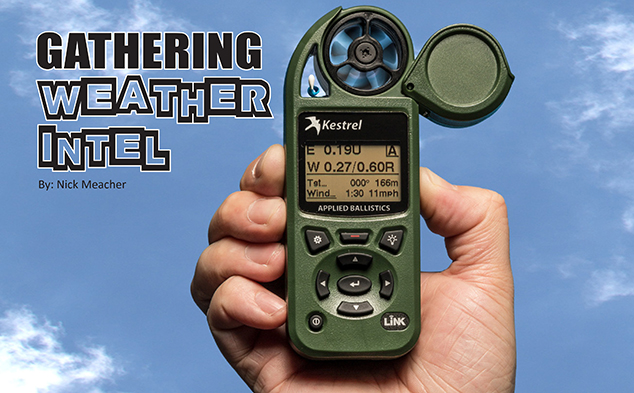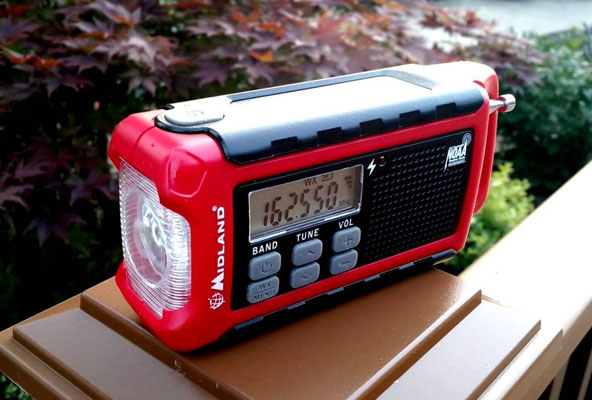Get uncensored intel and commentary from Survival Dispatch News
Subscribe to our RUMBLE channel

Spring usually brings severe weather in many parts of the country, sometimes with very little notice. I think most would agree that tornadoes are one of the worst in terms of little or no notice. In contrast, hurricanes or blizzards come with at least several days’ notice.
In normal situations we all probably have at least one app on our phone to track weather. We probably also have our phones set to give us news and weather alerts. As we’ve mentioned in previous articles, you should have radios for communications. Most VHF radios (Baofeng’s, etc.) should have the ability to monitor the National Oceanic and Atmospheric Administration (NOAA) and National Weather Service (NWS) weather radio frequencies.
Weather Intel Radio
The NOAA weather broadcasts use seven frequencies between 162.400 to 162.550 and vary by location. It’s important to use the correct frequency for your area because NOAA sends specific messages and alerts based on geographical areas using Specific Area Message Encoding (SAME). Each county or municipal area has a specific code that can be entered into a weather radio. It will then alert to the county and weather type based on the code.

The same system is part of the Emergency Alert System (EAS). There are event codes for weather events and also evacuations, civil emergencies, hazardous materials, nuclear plant warnings, and others.
There are lots of options for weather radios, including some that have solar power, hand cranks, connections for USB power charging of devices, etc. Some are just weather radios and others can also pick up local AM and FM radio stations.
Local stations would rebroadcast the alerts before the days of internet based radio and TV. While they still do, a large number of people who utilize internet based services may not receive the alerts. It’s important to have other means to receive these alerts. Have a weather radio in your vehicle when traveling so you aren’t relying on local stations.
Other Sources for Weather Intel
Most municipalities have a siren system if you live close enough to a town to hear it. However, these are usually only activated for a warning and not watches. Another source of notifications is Amateur Radio. Some ham repeaters are programmed to rebroadcast the watches and alerts.
Other areas have Skywarn or weather nets. Skywarn is a program of the NWS to train weather observers. Usually most NWS offices offer a number of courses prior to severe weather season. In addition to in person classes they offer a basic online class. Many Skywarn observers are also ham radio operators and many areas will conduct a weather or Skywarn net on a local repeater to coordinate messages to the local NWS office. Additionally, most NWS offices have ham radio stations.
In my area there is a daily weather net year round with people reporting their local weather which is then forwarded to the local NWS office.
Know Your Area
You should educate yourself on the weather patterns in your area. Peak tornado season is April-June, although tornadoes have occurred outside that time. The U.S. averages 1,225 tornadoes each year, with 55% occurring between April through June. The more severe ones also tend to occur during this time.
Tornadoes aren’t the only weather hazards as there’s severe thunderstorms, hail, high winds etc. that can all cause severe damage. Along the coast lines hurricanes are a hazard. While they bring high winds, it’s usually the surging water that kills more people.
Do It Yourself Weather Intel
A Skywarn class will give you some basic understanding of weather and what to look for in changing patterns. You can enhance your ability to monitor it with a weather station. Over the years a number of weather stations have developed on the market for amateur weather spotters.
These can be a simple clock with a remote that’s placed outside to give you temperature and also indicates a change in the barometric pressure with symbols. Other stations include complete home stations, rain and wind gauges, wind speed and direction, and barometric pressure.
There are also lightning detectors which are great when doing outdoor activities.
Hand-held weather monitor are perfect when in the field, hiking, or otherwise on the move. These vary from a simple wind and temperature gauge to devices that have humidity sensors, barometric, altitude, and air density sensors. Those who do long range shooting probably have one of these already. I personally have a basic Kestrel station as well as a more advanced Extech 45158 station as an upgrade.
Conclusions
I highly recommend that you take a Skywarn course and learn the weather patterns in your area. Your local NWS has probably scheduled their classes for the year. If you can’t find or get into a local one, then at least take the online class.
You should also check your local ham nets and club to see which ones run a weather net and/or provide alerts on their repeaters. The easiest way to find them is to search Repeater Book for your state. You’ll find an index for weather nets and Skywarn. You can still listen in without a ham license, but I strongly urge you to get one (see articles in the February edition of Survival Dispatch Insider). I also strongly suggest getting a weather alert radio to carry with you.
Once programmed with the SAME code for your area it will remain silent until an alert is received. This is handy as it can be set up to alert you at night.
You should also identify suitable space in your home and work place that can be used as a tornado shelter. Be sure to have your family practice before tornado season starts.
This article was originally published in Survival Dispatch Insider magazine Volume 2 Issue 5.
=====
Become a Survival Dispatch Insider …
We bring together survival enthusiasts and preppers to share skills and knowledge, so you can enhance your preparedness for emergencies and ensure the safety of you and your community.
The Results You’ll Get …
Our community, courses, and memberships are pretty special. We focus on the ways it will make a huge difference in your life.
Here are a few of the things you’ll be able to do as a member of Survival Dispatch Insider …
1) Improve your emergency preparedness by learning survival skills and strategies from experienced preppers. 2) Build lasting connections with like-minded individuals that share your passion for safety and readiness. 3) Access a wealth of knowledge and resources to assist in protecting you and your community during unexpected situations. Click HERE to get started.
=====
